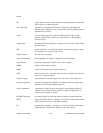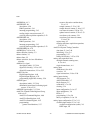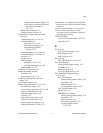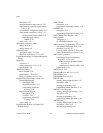
Index
AT-MIO-16X User Manual I-4
©
National Instruments Corporation
analog output specifications
differential nonlinearity, A-8
gain error, A-7
list of, A-6 to A-7
offset error, A-7
relative accuracy, A-7
AOGND signal
analog output connections, 2-30
description (table), 2-17, B-4
AT-MIO-16X. See also specifications; theory
of operation.
block diagram, 3-1
features, 1-1 to 1-2
initializing, 5-2 to 5-3
National Instruments application
software, 1-4 to 1-5
optional equipment, 1-7
overview
analog input, 1-2
analog output, 1-2
digital and timing I/O, 1-3
requirements for getting started, 1-3 to 1-4
software programming choices
NI-DAQ driver software, 1-5 to 1-6
register-level programming, 1-6
unpacking, 1-7
B
B6 through B0 bits, 5-40
base I/O address selection, 2-3 to 2-6
changing software to match (note), 2-4
default settings of National Instruments
products (table), 2-4 to 2-5
example switch settings (figure), 2-3
switch settings, with base I/O address and
address space (table), 2-5 to 2-6
BDIO<0..3> signal
description (table), 2-17, B-4
digital I/O circuitry, 3-24 to 3-25
digital I/O connections, 2-31 to 2-32
BDIO<3..0> bits
Digital Input Register, 4-69
Digital Output Register, 4-70
programming digital I/O circuitry, 5-36
BIPDAC0 bit, 4-10
BIPDAC1 bit, 4-10
bipolar input, 2-10
bipolar mode, analog output voltage versus
digital code (table), 4-42 to 4-43
bipolar output, 2-12
bits
A2DRV, 4-10, 5-38 to 5-39
A2RCV, 4-10, 5-38 to 5-39
A4DRV, 4-9, 5-38 to 5-39
A4RCV, 4-9, 5-35, 5-38 to 5-39
A6 through A0, 5-40
ADC_BUSY*, 4-30
ADCDSP, 4-13
ADCFIFOEF*, 4-26, 5-7, 5-22,
5-41, 5-43
ADCFIFOHF*, 4-26, 5-22, 5-41, 5-43
ADCFIFOREQ, 4-23
ADCREQ, 4-16 to 4-18
ADIO<3..0>, 4-69, 4-70, 5-36
B6 through B0 bits, 5-40
BDIO<3..0>, 4-69, 4-70, 5-36
BIPDAC0, 4-10
BIPDAC1, 4-10
BYTEPTR, 4-67
C<7..0>, 4-66
CFGMEMEF*, 4-29
CHAN_AIS, 4-35
CHAN_BIP, 4-36
CHAN_CAL, 4-35
CHAN_DSP, 4-38 to 4-39
CHAN_GHOST, 4-38
CHAN_LAST, 4-38, 5-15
CHAN_SE, 4-35
CHANSEL<3..0>, 4-36 to 4-37


















